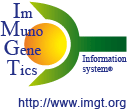The Populations under studies
Caucasoids
Samples [1] include unrelated Lebanese, Tunisian, and French individuals.
Lebanese
The Lebanese population comprises seven main communities: three Moslem (Sunnite, Shiite, and Druze) and four Christian (Maronite, Orthodox Greek, Catholic Greek, and Armenian, the latter composed of Orthodox and Catholics). At the time of the study the intercommunity unions were relatively rare. Some results of investigations in Lebanon have been previously reported [2-5].
Tunisian
The Tunisian population consists of a mixture of Berbers, Tunisia's aboriginal population, with a compound of many invaders and immigrants such as Phoenicians, Greeks, Romans, Vandals, Byzantines, Arabs, Andalusians, Ottoman Turks, French'. It is difficult to evaluate the contribution of each of these various ethnic groups. The population under study [1] is homogeneous and may be supposed to descend from these immigrant groups but does contain a major Berber component. They live in Mahdia and Sfax on the sea coast [6].
Black Africans [7]
Blood samples were collected from unrelated healthy black African persons originating from various countries: Ivory Coast, Ghana, Togo, Cameroun, Congo, Gabon, Senegal, Nigeria, and Burundi. The other investigated DNAs were obtained from unrelated Tunisian and Lebanese individuals whose Gm genotypes, previously determined, revealed Negroid Gm haplotypes in their gene pools.
Mandenka [8]
The Mandenka population from Niokholo region of eastern Senegal (West Africa) is a small endogamous community, represented by some 3200 individuals living in a dozen villages, and having occasional contact with neighboring tribes [9-11]. Their language belongs to the Niger-Congo Mande family, which includes several million people located between Nigeria and the Atlantic coast. Historical information indicates that the Niokholo Mandenkalu (plural for Mandenka) came from the East and settled in West Africa during the 14th century. Several serological and DNA polymorphisms have previously been analyzed in this population [12-17] and have shown its close genetic relationship to other West African and, more generally, Niger-Congo popul tions.
Northern Selkups [18]
The Northern Selkups, a long-settled tribe inhabiting the north of western Siberia, are a population of about 2000. Before the invasion of Siberia by the Russians in the sixteenth century, the then more numerous Selkups used to live further to the south, in the Tomsk-Narym surroundings of Ob river. Driven off by nomads rushing in from the south and Russian settlers who were then occupying south and middle Siberia, the Selkups ventured, in the seventeenth century, on a great northbound migration towards the basins of the Turukhan and Taz rivers. Today, the Selkups live dispersed in seven localities in a vast territory of northern Siberia: Krasnoselkup, Farkovo, Tolka Krasnoselkupskaya, Kikki-Akki, Tolka Purovskaya, Ratta, Sovrechka. They have an influx of marriage migrants from surrounding peoples: the Khanti, the Kets, the Forest Nentsi. The Selkup language belongs to the north-Samodian branch of the Uralic family, as do the languages spoken by the Forest and Tundra Nentsi, Entsi and Nganasans. The Selkups subsequently lost their hitherto rich culture and only retain the native language and folklore. Their pursuits are fishing and hunting [19]. Being of Uralic anthropological type, the Selkups bear a stable and complex mix of Mongoloid and Caucasoid traits that mingled at the earliest stages of colonization of west Siberia by humans [20]. Gm studies have confirmed that the Northern Selkups are notably Caucasoid-Mongoloid hybrids [21]. The mixture apparently took place in the past in southern Siberia, after which the tribes moved northward. Natural selection, in the form of differential mortality, has made them fully adapted to the harsh climatic conditions of northern Siberia [22-24]. Blood group antigens, serum proteins and isozymes, mitochondrial DNA and Y-chromosome DNA have been studied for polymorphism. Only part of the data have been published to date [25, 26].
| [1] | Ghanem, N. et al., Eur. J. Immunol., 18, 1067-1072 (1988). |
| [2] | Lefranc, G. et al., Acta Anthropogenetica, 1, 34-45 (1976). |
| [3] | Lefranc, G. et al., Am. J. Hum. Genet., 28, 51-61 (1976). |
| [4] | Lefranc, G. et al., Hum. Genet., 41, 197-209 (1978). |
| [5] | Lalouel, J.M. et al., Acta Anthropogenetica, 1, 15-33 (1976). |
| [6] | Lefranc, G. et al., Hum. Genet., 50, 199-211 (1979). |
| [7] | Ghanem, N. et al., Hum. Genet., 83, 37-44 (1989). |
| [8] | Dard, P. et al., Hum. Genet., 98, 36-47 (1996). |
| [9] | Langaney, A. and Gomila, J., Hum. Biol., 45, 137-50 (1973). |
| [10] | Lalouel, J.M. and Langaney, A., Am. J. Phys. Anthropol., 45, 453-466 (1976). |
| [11] | Langaney, A. et al., Population, 4-5, 909-915 (1979). |
| [12] | Blanc, M. et al., Am. J. Hum. Genet., 46, 383-92 (1990). |
| [13] | Dard, P. et al., C. R. Acad. Sci. III, 314, 573-578 (1992). |
| [14] | Tiercy, J.M. et al., Am. J. Hum. Genet., 51, 592-608 (1992). |
| [15] | Graven, L. et al., Mol. Biol. Evol., 12, 334-345 (1995). |
| [16] | Martinson, J.J. et al., Am. J. Hum. Genet., 5, 1186-1198 (1995). |
| [17] | Poloni, E.S. et al., Ann. Hum. Genet., 59, 43-61, (1995). |
| [18] | Osipova, L.P. et al., Hum. Genet., 105, 530-541 (1999). |
| [19] | Pelikh, G.I. The origin of the Sel-kups, University Press, Tomsk [in Russian] (1972). |
| [20] | Debets, G.F. Sel'kupy (Antropologicheskii ocherk), Trudy instituta etnographii AN SSSR (novaya seriya), V2, Moskwa [in Russian] (1947). |
| [21] | Sukernik, R.I. et al., Exp. Clin. Immunogenet., 9, 15-23 (1992). |
| [22] | Dubrova, Y.E. et al., Genetika, 29, 1697-1701 [in Russian] (1993). |
| [23] | Oteva, E.A. et al., Ter. Arkh., 65, 21-24 [in Russian] (1993). |
| [24] | Fefelova, V.V. et al., Siberian Journal of Ecology, 2, 131-138 (1994). |
| [25] | Kazakovtseva, M.A. et al., Genetika, 34, 416-422 [in Russian] (1998). |
| [26] | Karafet, T.M. et al., Am. J. Hum. Genet., 64, 817-31 (1999). |



